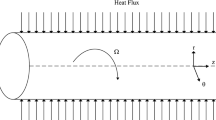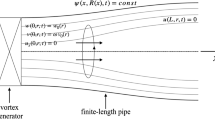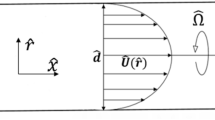Abstract
Direct numerical simulations have been performed with a high-order spectral element method computer code to investigate the Coriolis force effect on a fully-developed turbulent flow confined within a circular pipe subjected to radial system rotations. In order to study the radially rotating effects on the flow, a wide range of rotation numbers (Roτ) have been tested. In response to the system rotation imposed, large-scale secondary flows appear as streamwise counter-rotating vortices, which highly interact with the boundary layer and have a significant impact on the turbulent flow structures and dynamics. A quasi Taylor-Proudman region occurs at low rotation numbers, where the mean axial velocity is invariant along the rotating axis. As the rotation number increases, laminarization occurs near the bottom wall of the pipe, and the flow becomes fully laminarized when the rotation number approaches Roτ = 1.0. The characteristics of the flow field are investigated in both physical and spectral spaces, which include the analyses of the first- and second-order statistical moments, pre-multiplied spectra of velocity fluctuations, budget balance of the transport equation of Reynolds stresses, and coherent flow structures.














Similar content being viewed by others
References
Belhoucine, L., Deville, M., Elazehari, A.R., Bensalah, M.O.: Explicit algebraic Reynolds stress model of incompressible turbulent flow in rotating square duct. Comput. Fluids 33(2), 179–199 (2004)
Kristoffersen, R., Andersson, H.I.: Direct simulations of low-Reynolds-number turbulent flow in a rotating channel. J Fluid Mech. 256, 163–197 (1993)
Grundestam, O., Wallin, S., Johansson, A.V.: Direct numerical simulations of rotating turbulent channel flow. J. Fluid Mech. 598, 177–199 (2008)
Wallin, S., Grundestam, O., Johansson, A.V.: Laminarization mechanisms and extreme-amplitude states in rapidly rotating plane channel flow. J. Fluid Mech. 730, 193–219 (2013)
Xia, Z.-H., Shi, Y.-P., Chen, S.-Y.: Direct numerical simulation of turbulent channel flow with spanwise rotation. J. Fluid Mech. 788, 42–56 (2016)
Pallares, J., Davidson, L.: Large-eddy simulations of turbulent flow in a rotating square duct. Phys. Fluids 12(11), 2878–2894 (2000)
Dai, Y.-J., Huang, W.-X., Xu, C.-X., Cui, G.-X.: Direct numerical simulation of turbulent flow in a rotating square duct. Phys. Fluids 27(6), 065104 (2015)
Fang, X.-J., Yang, Z.-X., Wang, B.-C., Bergstrom, D.J.: Direct numerical simulation of turbulent flow in a spanwise rotating square duct at high rotation numbers. Int. J. Heat Fluid Flow 63, 88–98 (2017)
Narasimhamurthy, V.D., Andersson, H.I.: Turbulence statistics in a rotating ribbed channel. Int. J. Heat Fluid Flow 51, 29–41 (2015)
Xun, Q.-Q., Wang, B.-C.: Hybrid RANS/LES of turbulent flow in a rotating rib-roughened channel. Phys. Fluids 28(7), 075101 (2016)
Coletti, F., Lo Jacono, D., Cresci, I., Arts, T.: Turbulent flow in rib-roughened channel under the effect of Coriolis and rotational buoyancy forces. Phys. Fluids 26(4), 045111 (2014)
Tafti, D., Dowd, C., Tan, X.: High Reynold number LES of a rotating two-pass ribbed duct. Aerospace 5(4), 124 (2018)
Eggels, J., Unger, F., Weiss, M., Westerweel, J., Adrian, R., Friedrich, R., Nieuwstadt, F.: Fully developed turbulent pipe flow: a comparison between direct numerical simulation and experiment. J. Fluid Mech. 268, 175–210 (1994)
Wu, X.-H., Moin, P.: A direct numerical simulation study on the mean velocity characteristics in turbulent pipe flow. J. Fluid Mech. 608, 81–112 (2008)
Chin, C., Ooi, A.S.H., Marusic, I., Blackburn, H.M.: The influence of pipe length on turbulence statistics computed from direct numerical simulation data. Phys. Fluids 22(11), 115107 (2010)
Wu, X.-H., Baltzer, J.R., Adrian, R.J.: Direct numerical simulation of a 30R long turbulent pipe flow at R + = 685: Large- and very large-scale motions. J. Fluid Mech. 698, 235–281 (2012)
Barua, S.N.: Secondary flow in a rotating straight pipe. Proc. R. Soc. Lond. Ser. A. Math. Phys. Sci. 227(1168), 133–139 (1954)
Ishigaki, H.: Analogy between laminar flows in curved pipes and orthogonally rotating pipes. J. Fluid Mech. 268, 133–145 (1994)
Ishigaki, H.: Analogy between turbulent flows in curved pipes and orthogonally rotating pipes. J. Fluid Mech. 307, 1–10 (1996)
Lei, U., Lin, M.J., Sheen, H.J., Lin, C.M.: Velocity measurements of the laminar flow through a rotating straight pipe. Phys. Fluids 6(6), 1972–1982 (1994)
Blackburn, H.M., Sherwin, S.J.: Formulation of a Galerkin spectral element-Fourier method for three-dimensional incompressible flows in cylindrical geometries. J. Comp Phys. 197(2), 759–778 (2004)
Karniadakis, G.E., Israeli, M., Orszag, S.A.: High-order splitting methods for the incompressible Navier-Stokes equations. J. Comp Phys. 97(2), 414–443 (1991)
Sharma, R.K., Nandakumar, K.: Multiple, two-dimensional solutions in a rotating straight pipe. Phys. Fluids 7(7), 1568–1575 (1995)
El Khoury, G.K., Schlatter, P., Noorani, A., Fischer, P.F., Brethouwer, G., Johansson, A.V.: Direct numerical simulation of turbulent pipe flow at moderately high Reynolds numbers. Flow Turbul. Combust. 91(3), 475–495 (2013)
Di Liberto, M., Di Piazza, I., Ciofalo, M.: Turbulence structure and budgets in curved pipes. Comput. Fluids 88, 452–472 (2013)
Bolis, A., Cantwell, C.D., Moxey, D., Serson, D., Sherwin, S.J.: An adaptable parallel algorithm for the direct numerical simulation of incompressible turbulent flows using a Fourier spectral/hp element method and MPI virtual topologies. Comput. Phys. Commun. 206, 17–25 (2016)
Karniadakis, G.E., Sherwin, S.J.: Spectral/hp Element Methods for Computational Fluid Dynamics, 2nd edn. Oxford University Press, New York (2005)
Fang, X.-J., Wang, B.-C.: On the turbulent heat transfer in a square duct subjected to spanwise system rotation. Int. J. Heat Fluid Flow 71, 220–230 (2018)
Wagner, C., Hüttl, T.J., Friedrich, R.: Low-Reynolds-number effects derived from direct numerical simulations of turbulent pipe flow. Comput. Fluids 30(5), 581–590 (2001)
Chin, C., Monty, J.P., Ooi, A.: Reynolds number effects in DNS of pipe flow and comparison with channels and boundary layers. Int. J. Heat Fluid Flow 45, 33–40 (2014)
Zhou, J., Adrian, R.J., Balachandar, S., Kendall, T.M.: Mechanisms for generating coherent packets of hairpin vortices in channel flow. J. Fluid Mech. 387, 353–396 (1999)
Johnston, J.P., Halleen, R.M., Lezius, D.K.: Effects of spanwise rotation on the structure of two-dimensional fully developed turbulent channel flow. J. Fluid Mech. 56(3), 533–557 (1972)
Acknowledgments
The authors are thankful to Blackburn and Sherwin [21] for making their spectral-element code “Semtex” accessible to the research community. The authors would also like to thank Western Canada Research Grid (WestGrid) for an access to supercomputing and storage facilities. Research funding from Natural Sciences and Engineering Research Council (NSERC) of Canada to B.-C. Wang (grant number: RGPIN/357453-2013) is gratefully acknowledged.
Author information
Authors and Affiliations
Corresponding author
Ethics declarations
Conflict of interests
The authors declare that they have no conflict of interest.
Additional information
Publisher’s Note
Springer Nature remains neutral with regard to jurisdictional claims in published maps and institutional affiliations.
Appendix
Appendix
In this appendix, the transport equations of Reynolds stresses (\(\langle u^{\prime }_{z} u^{\prime }_{z}\rangle \), \(\langle u^{\prime }_{r} u^{\prime }_{r}\rangle \), \(\langle u^{\prime }_{z} u^{\prime }_{r}\rangle \) and \(\langle u^{\prime }_{\theta } u^{\prime }_{\theta }\rangle \)) in a cylindrical coordinate system are provided. Based on a literature study, it is concluded that there is a necessity to present these transport equations here, as the exact forms of these equations are not readily available in the literature.
The transport equation of \(\langle u^{\prime }_{z} u^{\prime }_{z}\rangle \) reads
The transport equation of \(\langle u^{\prime }_{r} u^{\prime }_{r}\rangle \) is
The transport equation of \(\langle u^{\prime }_{z} u^{\prime }_{r}\rangle \) is
The transport equation of \(\langle u^{\prime }_{\theta } u^{\prime }_{\theta }\rangle \) is
Rights and permissions
About this article
Cite this article
Zhang, ZP., Wang, BC. Direct Numerical Simulation of Turbulent Flow in a Circular Pipe Subjected to Radial System Rotation. Flow Turbulence Combust 103, 1057–1079 (2019). https://doi.org/10.1007/s10494-019-00062-8
Received:
Accepted:
Published:
Issue Date:
DOI: https://doi.org/10.1007/s10494-019-00062-8




